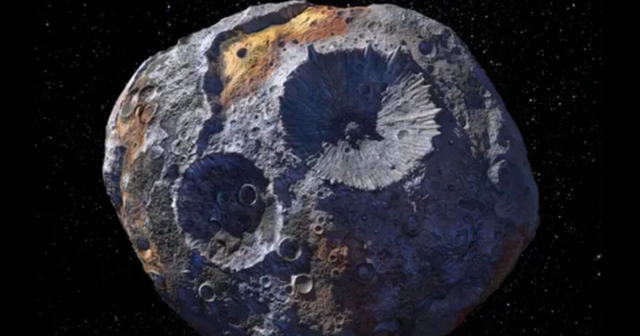
The world's most expensive asteroid, worth $100,000, may be rusting


A recent study using data from the James Webb Space Telescope (JWST) has revealed new insights into the mysterious asteroid 16 Psyche. Once thought to be a metallic remnant of a planetesimal core, Psyche is showing signs of hydration, suggesting a more complex history than previously believed. These findings could provide important clues about asteroid formation and the evolution of objects in the early solar system. The research, available on Arxiv, shows that Psyche's surface contains hydroxyl groups, which are typically associated with the formation of rust. This discovery has led to a rethinking of the asteroid's composition, which now appears to be a mixture of metals and silicate materials, possibly formed by impacts from water-rich asteroids. As scientists explore further, new insights into the origin and nature of this celestial body are emerging, challenging previous assumptions.
In March 2023, the James Webb Space Telescope's infrared instruments, the Near Infrared Spectrograph (NIRSpec) and the Mid-Infrared Instrument (MIRI), turned their focus toward Psyche's north pole. The resulting data revealed a hydroxyl signature on the asteroid's surface, suggesting the presence of water in the form of rust. NIRSpec observations confirmed the presence of hydroxyl groups, which are typically associated with water or hydrated minerals. Stephanie Jarmak, a planetary scientist at the Harvard-Smithsonian Center for Astrophysics, noted that the detection of hydroxyl signatures using JWST instruments "has helped other astronomers detect widespread molecular water on the moon, but it had not been used for asteroids before." This major discovery marks a significant advance in asteroid research and provides a clearer understanding of the materials that make up Psyche.
While the NIRSpec data confirmed the presence of hydroxyl groups, the MIRI data, which focuses on longer infrared wavelengths, did not reveal a definitive sign of water. Jarmak remains cautious, however, suggesting that water may still be present on Psyche, albeit at levels too low to be detected by MIRI. Future observations, particularly of the asteroid's south pole, could provide more definitive evidence, providing a clearer picture of how hydrated materials are distributed across its surface.
Psyche is a truly unique asteroid within the main asteroid belt. With a diameter of 280 kilometers at its widest point, it is significantly larger than many other asteroids, and its surface is believed to be rich in metal. Scientists initially hypothesized that Psyche might be the exposed metallic core of a planetesimal that suffered a catastrophic collision in the early solar system. However, over the years, new data has challenged this hypothesis, suggesting that the asteroid may have a more complex composition.
The latest findings from JWST add weight to the theory that Psyche is not made entirely of metal. Instead, it appears to be a mixed world, with both silicate and metal components. The presence of hydroxyl groups – indicating hydration – suggests that Psyche’s surface may have undergone processes similar to those on Earth and other planetary bodies. This raises the possibility that Psyche’s material was altered by impacts with hydrated asteroids, which would have deposited water or water-containing minerals on its surface. This new knowledge could help researchers understand the formation and evolution of such objects, as well as their role in the development of the early solar system.
The discovery of hydroxyl groups and possible rust on Psyche is just the beginning of a deeper exploration into the asteroid’s origins. NASA’s Psyche mission, which is set to launch in 2023, will arrive at the asteroid in 2029. Scientists are already planning additional studies to determine exactly where hydrated metals are found on Psyche’s surface. According to Jarmak, “future plans include studying exactly where hydrated metals are found on Psyche’s surface.” One area of interest is Psyche’s south pole, which contains a large crater that may have been created by an encounter with a hydrated impact object. This region will be critical for understanding how the asteroid’s surface was shaped by impacts and the role that hydrated materials played in its evolution.
Psyche's proximity to Earth and its unique composition make it a valuable target for further exploration. While mining efforts on Psyche are not currently cost-effective due to its location three times Earth's distance from the Sun, understanding its composition could provide crucial information for future space mining missions. If Psyche's metal-rich surface contains water-bearing minerals, this could pave the way for future mining ventures, although such efforts would need to address significant logistical challenges.

The Ukraine summit that ignored the tough questions
ideas
top
Alfa recipes
TRENDING 
services
- POLICE129
- STREET POLICE126
- AMBULANCE112
- FIREFIGHTER128





























